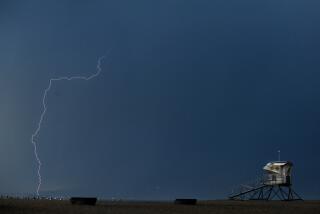Images from space, radar show Oklahoma tornadoes
Images showing the massive tornadoes spawned by “super cell” thunderstorms over Oklahoma, and the scars they left behind, have been released by NASA and the National Oceanic and Atmospheric Administration.
The images show the sudden outbreak of super-cell thunderstorms with strong, tight rotation.
The storms form where air masses with different temperatures and water content collide -- a common occurrence during the spring in the lower Midwest, where warm, moist air currents originating in the Gulf of Mexico meet drier, colder air masses from the upper Plains and Canada.
Warm air expands, which makes it less dense than surrounding air, so it rises. That creates a vacuum, which draws in cooler air from the sides. You can feel that breeze during any thunderstorm.
Differences in wind speed at different altitudes cause shear. Picture the barrel roll of a wave at the beach, where water at the bottom “drags” and slows, while faster layers outpace it, creating an overhang, which curls and falls.
How that continuous horizontal barrel roll in the atmosphere becomes vertical is somewhat mysterious, but the leading theory holds that the thunderstorm’s updraft tugs on the barrel while a downdraft from precipitation pushes its downward -- the barrel turns vertical and becomes a funnel cloud, or vortex. As the funnel cloud becomes more compact, it spins faster, much the way a figure skater will rotate faster by bringing her arms inward.
Below, you’ll find an animation that shows the movement of the storm systems in the south central United States on May 20. Images in the animation were collected with the NOAA’s GOES-13 satellite.







